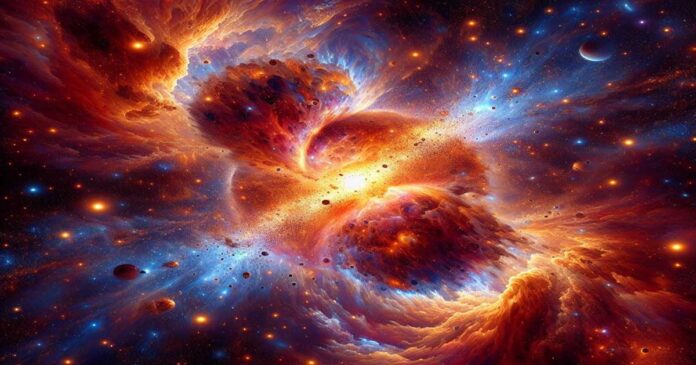In the vast expanse of space, where galaxies roam and interact, a cosmic dance unfolds, giving birth to dazzling displays of star formation.
When galaxies collide, it’s not just a collision of celestial bodies; it’s a catalyst for the creation of new stars and, potentially, entire planetary systems.
The Hubble Space Telescope, renowned for its unparalleled vision, has captured the aftermath of these collisions in stunning detail.
With its keen eye, it peers into the depths of space, revealing clusters of newborn stars scattered along the elongated trails of gas and dust known as tidal tails.
New Insights Unveiled
A recent study published in the Monthly Notices of the Royal Astronomical Society sheds light on these celestial phenomena.
Led by Michael Rodruck of Randolph-Macon College, a team of astronomers has delved into the mysteries of tidal tail star clusters, unraveling their ages, masses, and the dynamics of their parent galaxies.
Utilizing a combination of new observations and archival data, astronomers have determined that these star clusters are remarkably young, mere infants at just 10 million years old.
Moreover, they appear to be forming at a consistent rate along the sprawling tidal tails, spanning thousands of light-years.
Insights from the Experts
Associate Professor Sanchayeeta Borthakur, an observational astronomer from Arizona State University, underscores the significance of these findings.
She emphasizes that understanding the formation of stars in distant galaxies is crucial for unraveling the mysteries of our own Milky Way.
Galactic Evolution Unveiled
The tails of gas and dust stretching from merging galaxies offer a glimpse into the evolutionary process of celestial bodies.
Before the mergers, these galaxies were veiled in clouds of molecular hydrogen, dormant and undisturbed.
However, the gravitational interplay during their encounters ignited a frenzy of star formation, transforming inert clouds into veritable nurseries of stellar birth.
The Uncertain Destiny of Star Clusters
As these star clusters adorn the cosmic tapestry, their fate remains uncertain.
Will they coalesce into globular clusters orbiting their host galaxies, or will they disperse, adorning the galactic halo with their luminous presence?
Only time will tell as these celestial pearls continue to evolve and unfold their cosmic destiny.
A Glimpse into the Past
This spectacle of star formation serves as a window into the distant past of our universe.
These nearby galaxies observed by the Hubble Space Telescope offer a glimpse into a time when galactic collisions were more commonplace, shaping the cosmos as we know it today.
Conclusion
The discovery of newborn star clusters nestled within tidal tails underscores the dynamic nature of our universe.
With each collision and merger, new generations of stars are born, enriching the cosmic tapestry and providing insights into the processes that govern the formation of celestial bodies.
As astronomers continue to unravel the mysteries of the cosmos, the Hubble Space Telescope stands as a beacon of discovery, illuminating the wonders of the universe with unparalleled clarity and precision.
FAQs
Tidal tails are elongated regions of stars, gas, and dust that form when galaxies interact or collide. These tails are stretched out due to gravitational forces, creating spectacular displays in the cosmos.
The Hubble Space Telescope’s exceptional vision allows astronomers to observe tidal tails in unprecedented detail. By capturing images of newborn star clusters within these tails, Hubble provides valuable insights into the processes of star formation and galactic evolution.
The study, led by Michael Rodruck and his team, indicates that tidal tail star clusters are relatively young, with an age of around 10 million years. Furthermore, they seem to be forming consistently along the length of the tidal tails, spanning thousands of light-years.
Understanding the formation and evolution of star clusters within tidal tails offers valuable insights into the dynamics of galaxy interactions and the mechanisms driving star formation. This knowledge not only enhances our understanding of distant galaxies but also sheds light on the origins of stars within our own Milky Way.
More info: Michael Rodruck et al, Star clusters in tidal debris, Monthly Notices of the Royal Astronomical Society (2023). DOI: 10.1093/mnras/stad2886 , academic.oup.com/mnras/article/526/2/2341/7286662

